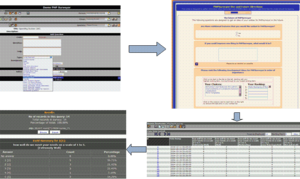Difference between revisions of "Measuring needs and preferences"
From E-Consultation Guide
(→Online surveys) |
|||
| (14 intermediate revisions by 3 users not shown) | |||
| Line 1: | Line 1: | ||
Finding out how many citizens have which needs, and what their preferences are between alternative options (e.g. through surveys, opinion polls, preferenda). | Finding out how many citizens have which needs, and what their preferences are between alternative options (e.g. through surveys, opinion polls, preferenda). | ||
| + | *Some consultations set out to find what particular groups of people need. | ||
| + | *Others try to find out what preferences people have between different options. | ||
| + | *In either case, apart from discussion systems, we often use surveys and votes to quantify the needs or preferences. | ||
| + | *Computers can help send out surveys, collect the results, and analyse them. They can also be used to run a quick vote in a meeting, or by subtle analysis of preferences, find underlying consensus between oponents. | ||
| − | == | + | ==E-polling/E-voting== |
| − | + | Here we are not talking about voting for representatives, but choosing options on issues. | |
| − | * | + | *voting software can help analyse votes |
| − | * | + | **[http://www.deborda.org/cdrom/cd1.html Deborda] |
| − | * | + | *voting hardware can collect votes from dozens or thousands of people at once |
| − | * | + | **wireless voting systems: [http://www.xtol.co.uk/demo.html Xtol], [http://www.turningtechnologies.com/ vPad] |
| − | * | + | **text message (SMS) voting |
| − | * | ||
| − | |||
| − | == | + | ==Online surveys== |
| + | [[Image:Survey.png|thumb|Online survey cycle]] | ||
| + | An online survey is designed to replace traditional paper questionnaires. | ||
| − | == Online | + | Examples: |
| + | #[http://www.e-consultation.org/phpsurveyor/index.php?sid=5 mobile phone Internet service] | ||
| + | #[http://www.e-consultation.org/phpsurveyor/index.php?sid=1 various types of survey question] | ||
| + | |||
| + | On-line Survey Cycle: | ||
| + | #Design the survey, edit the questions. | ||
| + | #Respondents fill in the survey in their web browsers. | ||
| + | #Send reminders and invitations by e-mail. | ||
| + | #Get statistics of results. | ||
| + | |||
| + | Online survey tools: | ||
| + | *Survey sites, such as [http://www.surveymonkey.com/ Survey Monkey] | ||
| + | *Free and Open Source Software, such as [http://www.phpsurveyor.org/ PHP Surveyor], which we have used | ||
| + | *Commercial software. Look for software written by people who understand web programming, not just crude attempts to replicate paper survey design on-line. | ||
| + | *Commercial services, provided by market research companies like [http://www.ums-research.com/ Milward Brown]. | ||
Latest revision as of 11:26, 8 December 2006
Finding out how many citizens have which needs, and what their preferences are between alternative options (e.g. through surveys, opinion polls, preferenda).
- Some consultations set out to find what particular groups of people need.
- Others try to find out what preferences people have between different options.
- In either case, apart from discussion systems, we often use surveys and votes to quantify the needs or preferences.
- Computers can help send out surveys, collect the results, and analyse them. They can also be used to run a quick vote in a meeting, or by subtle analysis of preferences, find underlying consensus between oponents.
E-polling/E-voting
Here we are not talking about voting for representatives, but choosing options on issues.
- voting software can help analyse votes
- voting hardware can collect votes from dozens or thousands of people at once
Online surveys
An online survey is designed to replace traditional paper questionnaires.
Examples:
On-line Survey Cycle:
- Design the survey, edit the questions.
- Respondents fill in the survey in their web browsers.
- Send reminders and invitations by e-mail.
- Get statistics of results.
Online survey tools:
- Survey sites, such as Survey Monkey
- Free and Open Source Software, such as PHP Surveyor, which we have used
- Commercial software. Look for software written by people who understand web programming, not just crude attempts to replicate paper survey design on-line.
- Commercial services, provided by market research companies like Milward Brown.
